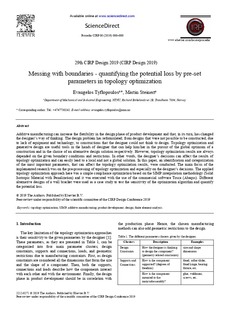| dc.contributor.author | Tyflopoulos, Evangelos | |
| dc.contributor.author | Steinert, Martin | |
| dc.date.accessioned | 2019-09-06T06:42:01Z | |
| dc.date.available | 2019-09-06T06:42:01Z | |
| dc.date.created | 2019-09-05T12:54:37Z | |
| dc.date.issued | 2019 | |
| dc.identifier.citation | Procedia CIRP. 2019, 84 979-985. | nb_NO |
| dc.identifier.issn | 2212-8271 | |
| dc.identifier.uri | http://hdl.handle.net/11250/2612839 | |
| dc.description.abstract | Additive manufacturing can increase the flexibility in the design phase of product development and that, in its turn, has changed the designer’s way of thinking. The design problem has reformulated; from designs that were not possible to be constructed, due to lack of equipment and technology, to constructions that the designer could not think to design. Topology optimization and generative design are useful tools in the hands of designer that can help him/her in the pursuit of the global optimum of a construction and in the choice of an alternative design solution respectively. However, topology optimization results are always depended on the given boundary conditions and restrictions. In other words, the designer’s decisions can affect the results of topology optimization and can easily lead to a local and not a global solution. In this paper, an identification and categorization of the most important parameters, that can affect the topology optimization results, were conducted. The main focus of the implemented research was on the pre-processing of topology optimization and especially on the designer’s decisions. The applied topology optimization approach here was a simple compliance optimization based on the SIMP interpolation methodology (Solid Isotropic Material with Penalization) and it was executed with the use of the commercial software Tosca (Abaqus). Different alternative designs of a wall bracket were used as a case study to test the sensitivity of the optimization algorithm and quantify the potential loss. | nb_NO |
| dc.language.iso | eng | nb_NO |
| dc.publisher | Elsevier | nb_NO |
| dc.rights | Attribution-NonCommercial-NoDerivatives 4.0 Internasjonal | * |
| dc.rights.uri | http://creativecommons.org/licenses/by-nc-nd/4.0/deed.no | * |
| dc.title | Messing with boundaries - quantifying the potential loss by pre-set parameters in topology optimization | nb_NO |
| dc.type | Journal article | nb_NO |
| dc.type | Peer reviewed | nb_NO |
| dc.description.version | publishedVersion | nb_NO |
| dc.source.pagenumber | 979-985 | nb_NO |
| dc.source.volume | 84 | nb_NO |
| dc.source.journal | Procedia CIRP | nb_NO |
| dc.identifier.doi | 10.1016/j.procir.2019.04.307 | |
| dc.identifier.cristin | 1721888 | |
| dc.description.localcode | © 2019 The Authors. Published by Elsevier B.V. This is an open access article under the CC BY-NC-ND license (http://creativecommons.org/licenses/by-nc-nd/4.0/). | nb_NO |
| cristin.unitcode | 194,64,92,0 | |
| cristin.unitname | Institutt for maskinteknikk og produksjon | |
| cristin.ispublished | true | |
| cristin.fulltext | postprint | |
| cristin.qualitycode | 1 | |

